+ Open data
Open data
- Basic information
Basic information
| Entry | Database: PDB / ID: 6qt9 | |||||||||||||||
|---|---|---|---|---|---|---|---|---|---|---|---|---|---|---|---|---|
| Title | Cryo-EM structure of SH1 full particle. | |||||||||||||||
 Components Components |
| |||||||||||||||
 Keywords Keywords | VIRUS / euryarcheal virus / SH1 | |||||||||||||||
| Function / homology | ORF 31 / ORF 25 / ORF 24 Function and homology information Function and homology information | |||||||||||||||
| Biological species |  Haloarcula hispanica virus SH1 Haloarcula hispanica virus SH1 | |||||||||||||||
| Method | ELECTRON MICROSCOPY / single particle reconstruction / cryo EM / Resolution: 3.8 Å | |||||||||||||||
 Authors Authors | De Colibus, L. / Roine, E. / Walter, T.S. / Ilca, S.L. / Wang, X. / Wang, N. / Roseman, A.M. / Bamford, D. / Huiskonen, J.T. / Stuart, D.I. | |||||||||||||||
| Funding support |  United Kingdom, United Kingdom,  Finland, 4items Finland, 4items
| |||||||||||||||
 Citation Citation |  Journal: Nat Commun / Year: 2019 Journal: Nat Commun / Year: 2019Title: Assembly of complex viruses exemplified by a halophilic euryarchaeal virus. Authors: Luigi De Colibus / Elina Roine / Thomas S Walter / Serban L Ilca / Xiangxi Wang / Nan Wang / Alan M Roseman / Dennis Bamford / Juha T Huiskonen / David I Stuart /    Abstract: Many of the largest known viruses belong to the PRD1-adeno structural lineage characterised by conserved pseudo-hexameric capsomers composed of three copies of a single major capsid protein (MCP). ...Many of the largest known viruses belong to the PRD1-adeno structural lineage characterised by conserved pseudo-hexameric capsomers composed of three copies of a single major capsid protein (MCP). Here, by high-resolution cryo-EM analysis, we show that a class of archaeal viruses possess hetero-hexameric MCPs which mimic the PRD1-adeno lineage trimer. These hetero-hexamers are built from heterodimers and utilise a jigsaw-puzzle system of pegs and holes, and underlying minor capsid proteins, to assemble the capsid laterally from the 5-fold vertices. At these vertices proteins engage inwards with the internal membrane vesicle whilst 2-fold symmetric horn-like structures protrude outwards. The horns are assembled from repeated globular domains attached to a central spine, presumably facilitating multimeric attachment to the cell receptor. Such viruses may represent precursors of the main PRD1-adeno lineage, similarly engaging cell-receptors via 5-fold spikes and using minor proteins to define particle size. | |||||||||||||||
| History |
|
- Structure visualization
Structure visualization
| Movie |
 Movie viewer Movie viewer |
|---|---|
| Structure viewer | Molecule:  Molmil Molmil Jmol/JSmol Jmol/JSmol |
- Downloads & links
Downloads & links
- Download
Download
| PDBx/mmCIF format |  6qt9.cif.gz 6qt9.cif.gz | 1.6 MB | Display |  PDBx/mmCIF format PDBx/mmCIF format |
|---|---|---|---|---|
| PDB format |  pdb6qt9.ent.gz pdb6qt9.ent.gz | 1.4 MB | Display |  PDB format PDB format |
| PDBx/mmJSON format |  6qt9.json.gz 6qt9.json.gz | Tree view |  PDBx/mmJSON format PDBx/mmJSON format | |
| Others |  Other downloads Other downloads |
-Validation report
| Arichive directory |  https://data.pdbj.org/pub/pdb/validation_reports/qt/6qt9 https://data.pdbj.org/pub/pdb/validation_reports/qt/6qt9 ftp://data.pdbj.org/pub/pdb/validation_reports/qt/6qt9 ftp://data.pdbj.org/pub/pdb/validation_reports/qt/6qt9 | HTTPS FTP |
|---|
-Related structure data
| Related structure data |  4633MC  4634C  4656C M: map data used to model this data C: citing same article ( |
|---|---|
| Similar structure data |
- Links
Links
- Assembly
Assembly
| Deposited unit | 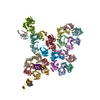
|
|---|---|
| 1 | x 60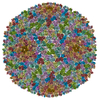
|
- Components
Components
-Protein , 7 types, 29 molecules ADCEFGHIJKLMabcdefijkmoglnhYW
| #1: Protein | Mass: 25042.207 Da / Num. of mol.: 2 / Source method: isolated from a natural source / Source: (natural)  Haloarcula hispanica virus SH1 / References: UniProt: Q4KPG2 Haloarcula hispanica virus SH1 / References: UniProt: Q4KPG2#2: Protein | Mass: 24913.094 Da / Num. of mol.: 10 / Source method: isolated from a natural source / Source: (natural)  Haloarcula hispanica virus SH1 / References: UniProt: Q4KPG2 Haloarcula hispanica virus SH1 / References: UniProt: Q4KPG2#3: Protein | Mass: 18840.627 Da / Num. of mol.: 11 / Source method: isolated from a natural source / Source: (natural)  Haloarcula hispanica virus SH1 / References: UniProt: Q4KPG3 Haloarcula hispanica virus SH1 / References: UniProt: Q4KPG3#4: Protein | Mass: 18272.000 Da / Num. of mol.: 3 / Source method: isolated from a natural source / Source: (natural)  Haloarcula hispanica virus SH1 / References: UniProt: Q4KPG3 Haloarcula hispanica virus SH1 / References: UniProt: Q4KPG3#5: Protein | | Mass: 19040.887 Da / Num. of mol.: 1 / Source method: isolated from a natural source / Source: (natural)  Haloarcula hispanica virus SH1 / References: UniProt: Q4KPG3 Haloarcula hispanica virus SH1 / References: UniProt: Q4KPG3#6: Protein | | Mass: 14982.346 Da / Num. of mol.: 1 / Source method: isolated from a natural source / Source: (natural)  Haloarcula hispanica virus SH1 / References: UniProt: Q4KPF6 Haloarcula hispanica virus SH1 / References: UniProt: Q4KPF6#8: Protein | | Mass: 6826.406 Da / Num. of mol.: 1 / Source method: isolated from a natural source / Source: (natural)  Haloarcula hispanica virus SH1 Haloarcula hispanica virus SH1 |
|---|
-Protein/peptide , 1 types, 1 molecules X
| #7: Protein/peptide | Mass: 2060.531 Da / Num. of mol.: 1 / Source method: isolated from a natural source / Source: (natural)  Haloarcula hispanica virus SH1 Haloarcula hispanica virus SH1 |
|---|
-Experimental details
-Experiment
| Experiment | Method: ELECTRON MICROSCOPY |
|---|---|
| EM experiment | Aggregation state: PARTICLE / 3D reconstruction method: single particle reconstruction |
- Sample preparation
Sample preparation
| Component | Name: Haloarcula hispanica virus SH1 / Type: VIRUS / Entity ID: all / Source: NATURAL |
|---|---|
| Molecular weight | Experimental value: NO |
| Source (natural) | Organism:  Haloarcula hispanica virus SH1 Haloarcula hispanica virus SH1 |
| Details of virus | Empty: NO / Enveloped: NO / Isolate: SPECIES / Type: VIRION |
| Natural host | Organism: Haloarcula hispanica virus SH1 |
| Virus shell | Name: Capsid / Diameter: 1000 nm / Triangulation number (T number): 28 |
| Buffer solution | pH: 7.2 / Details: 20mM Tris-HCl pH 7.2, 1M NaCl, 10 mM MnCl2 |
| Specimen | Conc.: 15 mg/ml / Embedding applied: NO / Shadowing applied: NO / Staining applied: NO / Vitrification applied: YES |
| Specimen support | Grid material: COPPER / Grid mesh size: 200 divisions/in. / Grid type: C-flat-2/1 |
| Vitrification | Instrument: FEI VITROBOT MARK IV / Cryogen name: ETHANE / Humidity: 100 % / Chamber temperature: 4 K |
- Electron microscopy imaging
Electron microscopy imaging
| Experimental equipment |  Model: Tecnai Polara / Image courtesy: FEI Company |
|---|---|
| Microscopy | Model: FEI POLARA 300 |
| Electron gun | Electron source:  FIELD EMISSION GUN / Accelerating voltage: 300 kV / Illumination mode: FLOOD BEAM FIELD EMISSION GUN / Accelerating voltage: 300 kV / Illumination mode: FLOOD BEAM |
| Electron lens | Mode: BRIGHT FIELD / Nominal magnification: 160000 X / Calibrated magnification: 37037 X |
| Specimen holder | Cryogen: NITROGEN / Specimen holder model: OTHER |
| Image recording | Average exposure time: 4.4 sec. / Electron dose: 1 e/Å2 / Detector mode: COUNTING / Film or detector model: GATAN K2 SUMMIT (4k x 4k) |
| EM imaging optics | Energyfilter name: GIF Quantum LS / Energyfilter slit width: 20 eV |
| Image scans | Movie frames/image: 22 |
- Processing
Processing
| Software | Name: PHENIX / Version: 1.14_3260: / Classification: refinement | |||||||||||||||||||||||||||||||||||||||||||||||||||||||
|---|---|---|---|---|---|---|---|---|---|---|---|---|---|---|---|---|---|---|---|---|---|---|---|---|---|---|---|---|---|---|---|---|---|---|---|---|---|---|---|---|---|---|---|---|---|---|---|---|---|---|---|---|---|---|---|---|
| EM software |
| |||||||||||||||||||||||||||||||||||||||||||||||||||||||
| CTF correction | Type: PHASE FLIPPING AND AMPLITUDE CORRECTION | |||||||||||||||||||||||||||||||||||||||||||||||||||||||
| Particle selection | Num. of particles selected: 16185 Details: This number of particle was generated by merging the datasets of full particles with and without spikes. | |||||||||||||||||||||||||||||||||||||||||||||||||||||||
| Symmetry | Point symmetry: C532 (532 fold cyclic) | |||||||||||||||||||||||||||||||||||||||||||||||||||||||
| 3D reconstruction | Resolution: 3.8 Å / Resolution method: FSC 0.143 CUT-OFF / Num. of particles: 16185 / Algorithm: BACK PROJECTION / Symmetry type: POINT | |||||||||||||||||||||||||||||||||||||||||||||||||||||||
| Atomic model building | B value: 144.281 / Protocol: BACKBONE TRACE / Space: REAL / Target criteria: Cross-correlation coefficient |
 Movie
Movie Controller
Controller



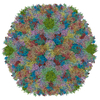
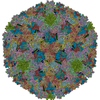
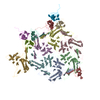

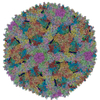
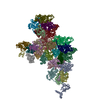

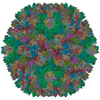
 PDBj
PDBj